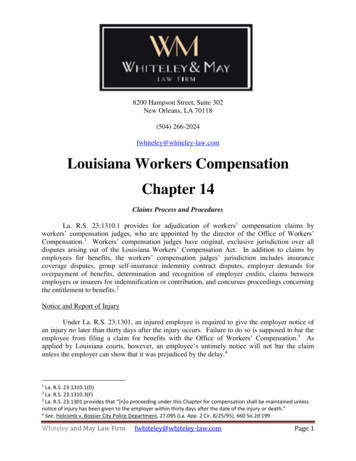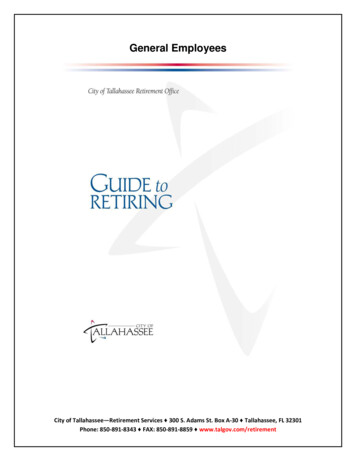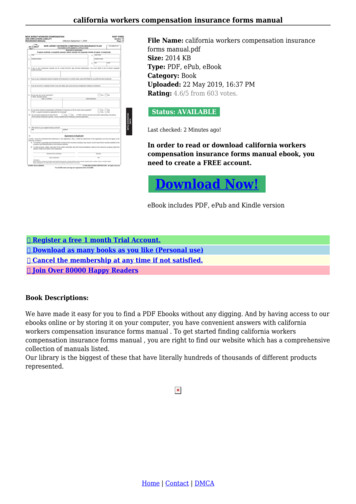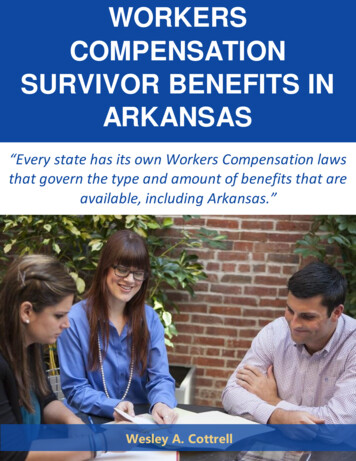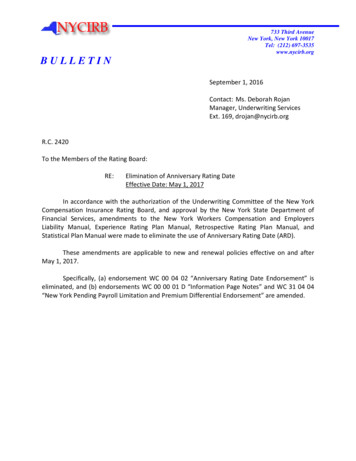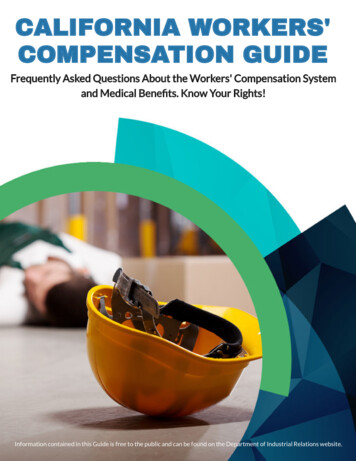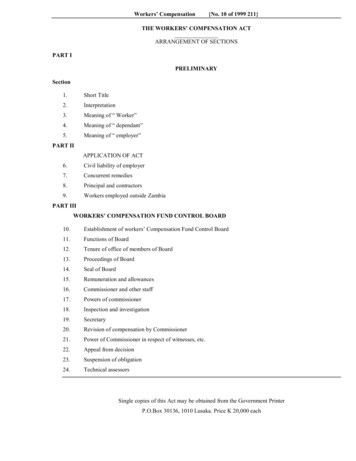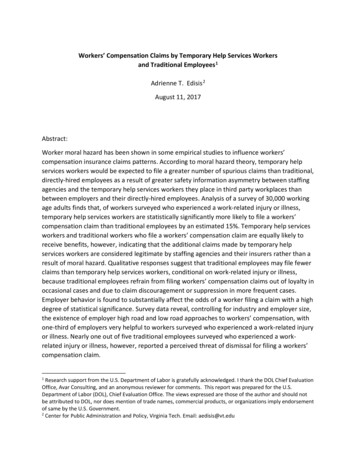
Transcription
Workers’ Compensation MedicareSet-Aside Arrangement (WCMSA)Reference GuideVersion 3.1May 11, 2020COBR-Q2-2020-v3.1
WCMSA Reference GuideTable of ContentsTable of Contents1.0About This Reference Guide . 11.12.0Changes in This Version of the Guide. 1Introduction to Workers’ Compensation and Medicare. 22.1Medicare as Secondary Payer . 22.2Reporting a WC Case . 22.3Past and Future Medical Services. 33.0What Are Workers’ Compensation Medicare Set-Aside Arrangements?. 44.0Should I Consider Submitting a WCMSA Proposal? . 55.04.1Considerations and Guidelines . 54.1.1 Commutation and Compromise . 54.1.2 Outstanding WC Claims . 54.1.3 Other Health Coverage . 54.1.4 Hearing on the Merits of a Case . 54.2Indications That Medicare’s Interests are Protected . 6WCMSA Funding Structures . 65.1Lump-Sum WCMSAs . 75.2Structured WCMSAs . 76.0Who Can Help with the WCMSA Process? . 77.0How is CMS Approval of a WCMSA Amount Obtained? . 88.0Should CMS Review a WCMSA? . 88.19.0Review Thresholds . 8WCMSA Submission Process Overview .109.1WCMSAP Submissions .119.2Paper or CD Submissions .129.3Receipt Review .129.4WCRC Review .129.4.1 WCRC Review Process .129.4.2 WCRC Team Background and Resources Used .139.4.3 WCRC Review Considerations .149.4.4 Medical Review .159.4.5 Medical Review Guidelines .239.4.6 Pharmacy .279.5Regional Office Receipt .339.6Final Determination .33ii
WCMSA Reference GuideTable of Contents10.0 Information Needed for WCMSA Submission . 3410.1 Section 05 – Cover Letter .3510.2 Section 10 – Consent to Release Note .4110.3 Section 15 – Rated Age Information or Life Expectancy .4310.4 Section 20 – Life Care / Future Treatment Plan .4410.4.1 Current Treatment .4510.4.2 Future Treatment .4510.5 Section 25 – Settlement Agreement or Proposed or Court Order .4710.5.1 Indicate How Much of the Settlement is for Past v. Future MedicalExpenses .4710.5.2 Use of WC Fee Schedule vs. Actual Charges for WCMSA .4810.5.3 Total Settlement Amount .4810.6 Section 30 – WCMSA Administration Agreement.4810.7 Section 35 – Medical Records .4910.8 Section 40 – Payment History .5010.9 Section 50 – Supplemental or Additional Information .5111.0 How do I submit a WCMSA? . 5111.1 Electronic Submission via the WCMSAP .5111.1.1 Benefits of Using the WCMSAP .5211.2 Paper Copy/CD Submission via the Mail.5211.2.1 Paper Copy .5211.2.2 CD.5212.0 What Happens after a WCMSA Has Been Submitted? . 5313.0 Sample Submission . 5414.0 Tips for Improving Your WCMSA Review Process . 5415.0 Review Process and Policies . 5415.1 Time Frame .5515.2 Criteria .5515.2.1 Compromise of Future Medical Expenses .5615.2.2 No Waivers of Specific Services Related to Future Medicals.5615.3 Case Status and Communications .5616.0 Review Following Conditional Approval. 5716.1 Re-Review .5716.2 Amended Review.5816.3 Required Resubmission .5917.0 Account Set-Up and Administration . 59iii
WCMSA Reference GuideTable of Contents17.1 Administrators .5917.2 Interest-Bearing Account .6017.3 Use of the Account .6017.4 Medicare Entitlement and WCMSA .6017.4.1 Loss of Medicare Entitlement after CMS Approval of a WCMSA .6117.4.2 Use of WC Settlement Funds Prior to Medicare Entitlement.6117.5 Annual Attestation and Record-Keeping .6117.6 Electronic Attestations .6217.7 MyMedicare.gov Link .6218.0 CMS’ Monitoring . 6319.0 What Happens if Circumstances Change? . 6419.1 WCMSA is Under-Funded .6419.2 Death of the Claimant .6419.3 Structured WCMSA Funds Topics .6419.3.1 Funds Left Over/Carried Forward .6419.3.2 Funds Used in a Given Period .6419.4 Change of Submitter .65Appendix 1. Contact Information .66Appendix 2. Abbreviations List .68Appendix 3. Glossary .70Appendix 4. WCRC Proposal Review Reference Tools .73Appendix 5. Sample Letters.75Approval Letter.75Zero Set-Aside Letter .78Below Threshold Letter .80Beneficiary Below Threshold Letter .82Development Letter .84Closeout Letter.90Appendix 6. Sample Submission .92Appendix 6: 05 – Cover Letter.93Appendix 6: 10 – Consent to Release Note.98Appendix 6: 15 – Rated Age Information or Life Expectancy .100Appendix 6: 20 – Life Care/Future Treatment Plan .104Appendix 6: 25 – Settlement Agreement or Proposed or Court Order .106Appendix 6: 30 – WCMSA Administration Agreement .110Appendix 6: 35 – Medical Records .114Appendix 6: 40 – Payment History .127iv
WCMSA Reference GuideTable of ContentsAppendix 7. List of Previous Version Changes .131FiguresFigure 9-1: WCMSA Submission Process Overview . 11Figure 9-2: WCRC Medical Review Steps. 16Figure 10-1: Blank Consent to Release Note . 42Figure 10-2: Example Consent to Release with Instructions . 43TablesTable 9-1: Verifying Jurisdiction and Calculation Method (Normal Pricing) . 18Table 9-2: Verifying Jurisdiction and Calculation Method (Other Pricing) . 19Table 9-3: Spinal Cord Stimulator Surgery CPT Codes . 25Table 10-1: WCMSA Document Requirements Checklist . 34Table Appendix 4-1: WCRC Proposal Review Reference Tools . 73v
WCMSA Reference GuideConfidentiality StatementConfidentiality StatementThe collection of this information is authorized by Section 1862(b) of the Social Security Act(codified at 42 U.S.C 1395y(b)) (see also 42, C.F.R. 411.24). The information collected will beused to identify and recover past conditional and mistaken Medicare primary payments and toprevent Medicare from making mistaken payments in the future for those Medicare SecondaryPayer situations that continue to exist. The Privacy Act (5 U.S.C. 552a(b)), as amended, prohibitsthe disclosure of information maintained by the Centers for Medicare & Medicaid Services(CMS) in a system of records to third parties, unless the beneficiary provides a written request orexplicit written consent/authorization for a party to receive such information. Where thebeneficiary provides written consent/proof of representation, CMS will permit authorized partiesto access requisite information.vi
WCMSA Reference Guide1.0About This Reference GuideThis guide was written to help you understand the process used by the Centers for Medicare &Medicaid Services (CMS) for approving proposed Workers’ Compensation Medicare Set-AsideArrangement (WCMSA) amounts and to serve as a reference for those choosing to submit suchamounts to CMS for approval. Submitters may include injured workers themselves (claimants),their attorneys, Workers’ Compensation (WC) Medicare Set-Aside Arrangement (MSA) agentsor consultants, or claimants’ other appointed representatives.This guide reflects information compiled from all WCMSA Regional Office (RO) Memorandaissued by CMS, from information provided on the CMS website, from information provided bythe Workers Compensation Review Contractor (WCRC), and from the CMS WCMSA OperatingRules. The intent of this reference guide is to consolidate and supplant all historical memorandain a single point of reference. Please discontinue the reference of prior documents.There are no statutory or regulatory provisions requiring that you submit a WCMSA amountproposal to CMS for review. If you choose to use CMS’ WCMSA review process, the Agencyrequests that you comply with CMS’ established policies and procedures.1.1Changes in This Version of the GuideVersion 3.1 of this guide includes the following changes: The Life Table link has been updated (Section 10.3).1
WCMSA Reference Guide2.0Introduction to Workers’ Compensation andMedicare2.1Medicare as Secondary Payer“Medicare Secondary Payer” (MSP) is the term used when the Medicare program does not haveprimary payment responsibility on behalf of its beneficiaries—that is, when another entity hasthe responsibility for paying for medical care before Medicare. Until 1980, the Medicareprogram was the primary payer in all cases except those involving WC (including Black Lungbenefits) or for care that is the responsibility of another government entity. With the addition ofthe MSP provisions in 1980 (and subsequent amendments), Medicare is secondary payer togroup health plan insurance in specific circumstances, but is also secondary to liability insurance(including self-insurance), no-fault insurance, and WC. An insurer or WC plan cannot, bycontract or otherwise, supersede federal law, for instance by alleging its coverage is“supplemental” to Medicare.WC is a primary payer to the Medicare program for Medicare beneficiaries’ work-relatedillnesses or injuries. Medicare beneficiaries are required to apply for all applicable WC benefits.If a Medicare beneficiary has WC coverage, providers, physicians, and other suppliers must billWC first.In order to comply with 42 U.S.C. § 1395y(b)(2) and § 1862(b)(2)(A)(ii) of the Social SecurityAct, Medicare may not pay for a beneficiary's medical expenses when payment “has been madeor can reasonably be expected to be made under a workers’ compensation plan, an automobile orliability insurance policy or plan (including a self-insured plan), or under no-fault insurance.” Ifresponsibility for the WC claim is in dispute and WC will not pay promptly, the provider,physician, or other supplier may bill Medicare as primary payer. If the item or service isreimbursable under Medicare rules, Medicare may pay conditionally, subject to later recovery ifthere is a subsequent settlement, judgment, award, or other payment. (See 42 C.F.R. § 411.21 forthe definition of “promptly” with regard to WC.)2.2Reporting a WC CaseAll WC occurrences that involve a Medicare beneficiary should be reported to the BenefitsCoordination & Recovery Center (BCRC). If you are a Responsible Reporting Entity (RRE)making an initial report of ongoing responsibility, use the Section 111 COB Secure Website forreporting. For the submission of WCMSA information, contact the BCRC by phone or mail.Customer Service Representatives are available Monday through Friday, from 8:00 a.m. to 8:00p.m., Eastern Time, except holidays. The BCRC's toll free number is 1-855-798-2627 orTTY/TDD: 1-855-797-2627 for the hearing and speech impaired.Written reports of WC occurrences should be addressed to:Medicare—Medicare Secondary PayerMedicare Secondary Payer Claims Investigation ProjectP.O. Box 138897Oklahoma City, OK 73113-88972
WCMSA Reference GuideNOTE: This mailing address is for reporting a WC occurrence, not for the submission ofproposed WCMSA amounts. See What Are Workers’ Compensation Medicare Set-AsideArrangements? for an explanation of WCMSAs, or Paper Copy/CD Submission via the Mail forthe WCMSA submission address.When contacting the BCRC to report a new WC occurrence by phone or by mail, please be sureto have the following information available:Injured person’s nameInjured person's Medicare ID (Health Insurance Claim Number [HICN] or MedicareBeneficiary Identifier [MBI]) or Social Security Number (SSN) Date of incident Nature of illness/injury Name and address of the WC insurance carrier Name and address of the injured person’s legal representatives Name of insured Policy/claim numberOnce this information is received, the BCRC will apply it to the beneficiary’s Medicare recordand send it to the Commercial Repayment Center (CRC) for processing. The CRC will issue aConditional Payment Letter (CPL) or Conditional Payment Notice (CPN) to the insurer, copiedto the beneficiary, explaining Medicare’s recovery rights with respect to conditional paymentsand outlining next steps in the process. Please note that Medicare's interests cannot bedetermined until the specifics of the WC occurrence are noted on the beneficiary's record. Forinquiries after submission of the WC occurrence, beneficiaries and their representatives shouldcontact the BCRC using the contact information above or in Appendix 1, and non-beneficiariesshould contact the CRC at 1-855-798-2627 (TTY/TDD: 1-855-797-2627 for the hearing andspeech impaired). 2.3Past and Future Medical ServicesGenerally, the term “past medical services” refers to Medicare-covered and otherwisereimbursable items and services that the beneficiary receives before he or she obtains a WCsettlement, judgment, award, or other payment. The term “future medical services” refers toMedicare-covered and otherwise-reimbursable items and services that the beneficiary receivesafter he or she obtains a settlement, judgment, award, or other payment.In situations in which Medicare has paid for WC-claim-related care before the beneficiary hasobtained a settlement, judgment, award, or other payment, those Medicare payments are referredto as “conditional payments.” They are considered conditional payments because Medicare paysunder the condition that it is reimbursed when the beneficiary gets a WC settlement, judgment,award, or other payment.Medicare is required by statute (42 U.S.C. § 1395y(b)) to seek reimbursement for conditionalpayments related to the settlement. Further, Medicare is prohibited from making payment wherepayment has been made (that is, where the beneficiary obtains a settlement, judgment, award, orother payment). Medicare remains the secondary payer until the settlement proceeds areappropriately exhausted. In many situations, the parties to a WC settlement choose to pursue a3
WCMSA Reference GuideCMS-approved WCMSA amount in order to establish certainty with respect to the amount thatmust be appropriately exhausted before Medicare begins to pay for care related to the WCsettlement, judgment, award, or other payment.Note: If Medicare is pursuing recovery directly from the WC insurer, the beneficiary, attorney,or other representative will receive a copy of recovery correspondence sent to the WC insurer.For more information on insurer recovery, see the Non-Group Health Plan Recovery page:http://go.cms.gov/NGHPR.3.0What Are Workers’ Compensation Medicare SetAside Arrangements?A WCMSA allocates a portion of the WC settlement for all future work-injury-related medicalexpenses that are covered and otherwise reimbursable by Medicare (“Medicare covered”). Whena proposed WCMSA amount is submitted to CMS for review and the claimant (who may or maynot be a beneficiary) obtains CMS’ approval, the CMS-approved WCMSA amount must beappropriately exhausted before Medicare will begin to pay for care related to the beneficiary’ssettlement, judgment, award, or other payment.The goal of establishing a WCMSA is to estimate, as accurately as possible, the total cost thatwill be incurred for all medical expenses otherwise reimbursable by Medicare for work-injuryrelated conditions during the course of the claimant’s life, and to set aside sufficient funds fromthe settlement, judgment, or award to cover that cost. WCMSAs may be funded by a lump sumor may be structured, with a fixed amount of funds paid each year for a fixed number of years,often using an annuity.Any claimant who receives a WC settlement, judgment, or award that includes an amount forfuture medical expenses must take Medicare’s interest with respect to future medicals intoaccount. If Medicare’s interests are not considered, CMS has a priority right of recovery againstany entity that received any portion of a third-party payment either directly or indirectly—a rightto recover, or take back, that payment. CMS also has a subrogation right with respect to any suchthird-party payment. "Subrogation" literally means the substitution of one person or entity foranother. If Medicare exercises its subrogation rights, Medicare is a claimant against theresponsible party and the liability insurer to the extent that Medicare has made payments to or onbehalf of the beneficiary for services related to claims against the responsible party (and theresponsible party’s liability insurance). In this example, Medicare is substituting for the claimantin this situation. Medicare can be a party to any claim by a beneficiary or other entity against aresponsible party and/or his/her liability insurance, and can participate in negotiations concerningthe total liability insurance payment and the amount to be repaid to Medicare.Medicare may also refuse to pay for future medical expenses related to the WC injury until theentire settlement is exhausted. These arrangements are typically not created until the individual’scondition has stabilized so that it can be determined, based on past experience, what the futuremedical expenses may be. CMS prefers this, so that future medical and prescription drug costscan be planned with a reasonable degree of certainty.Once the CMS-approved set-aside amount is exhausted and accurately accounted for to CMS,Medicare will pay primary for future Medicare-covered expenses related to the WC injury thatexceed the approved set-aside amount.4
WCMSA Reference Guide4.0Should I Consider Submitting a WCMSAProposal?4.1Considerations and GuidelinesAn individual or beneficiary may consider seeking CMS approval of a proposed WCMSAamount for a variety of reasons. The primary benefit is the certainty associated with CMSreviewing and approving the proposed amount with respect to the amount that must beappropriately exhausted. It is important to note, however, that CMS approval of a proposedWCMSA amount is not required.4.1.1 Commutation and CompromiseWC cases may involve past medical expenses, future medical expenses, or both. When asettlement includes compensation for medical expenses incurred prior to the settlement date, it isreferred to as a “WC compromise case.” When a settlement includes compensation for futuremedical expenses, it is referred to as a “WC commutation case.” A settlement also has acommutation aspect if it does not provide for future medical expenses when the facts of the caseindicate the need for continued medical care related to the WC illness or injury. A WCsettlement can have both compromise and commutation aspects.4.1.2 Outstanding WC ClaimsIf a Medicare beneficiary has outstanding WC-related claims that were not paid by eitherMedicare or the WC carrier prior to the settlement, the beneficiary is required to pay for relatedunpaid medicals bills out of his or her WC settlement. Medicare cannot pay because it issecondary to the WC settlement.4.1.3 Other Health CoverageA WCMSA is still recommended when you have coverage through other private healthinsurance, the Veterans Administration, or Medicare Advantage (Part C). Other coverage couldbe cancelled or you could elect not to use such a plan. A WCMSA is primary to MedicareAdvantage and must be exhausted before using Part C benefits on your WC illness or injury.4.1.4 Hearing on the Merits of a CaseBecause the CMS prices based upon what is claimed, released, or released in effect, the CMSmust have documentation as to why disputed cases settle future medical costs for less than therecommended pricing. As a result, when a state WC judge or other binding party approves a WCsettlement after a hearing on the merits, Medicare generally will accept the terms of thesettlement, unless the settlement does not adequately address Medicare’s interests. This shallinclude all denied liability cases, whether in part or in full. If Medicare’s interests were notreasonably considered, Medicare will refuse to pay for services related to the WC injury (andotherwise reimbursable by Medicare) until such expenses have exhausted the entire dollaramount of the entire WC settlement. Medicare may also assert a recovery claim, if appropriate.5
WCMSA Reference GuideIf a court or other adjudicator of the merits (e.g., a state WC board or commission) specificallydesignates funds to a portion of a settlement that is not related to medical services (e.g., lostwages), then Medicare will accept that designation.4.2Indications That Medicare’s Interests are ProtectedSubmitting a WCMSA proposed amount for review is never required. But WC claimants mustalways protect Medicare’s interests. A WCMSA is not necessary under the following conditionsbecause when all three are true, they indicate that Medicare’s interests are already protected:a) The facts of the case demonstrate that the injured individual is only being compensatedfor past medical expenses (i.e., for services furnished prior to the settlement);b) There is no evidence that the individual is attempting to maximize the other aspects of thesettlement (e.g., the lost wages and disability portions of the settlement) to Medicare’sdetriment; andc) The individual's treating physicians conclude (in writing) that to a reasonable degree ofmedical certainty the individual will no longer require any Medicare-covered treatmentsrelated to the WC injury.In addition, if a settlement leaves WC carriers with responsibility for ongoing medical andprescription coverage once the settlement funds are fully spent, then a WCMSA is not necessary.Notes: 5.0If Medicare made any conditional payments for WC injury-related services furnishedprior to settlement, then Medicare will recover those payments. In addition, Medicarewill not pay for any WC injury-related services furnished prior to the date of thesettlement for which it has not already paid.CMS will not issue “verification letters” stating that a WCMSA is not necessary.CMS’ voluntary, yet recommended, WCMSA amount review process is the only processthat offers both Medicare beneficiaries and Workers’ Compensation entities finality, withrespect to obligations for medical care required after a settlement, judgment, award, orother payment occurs. When CMS reviews and approves a proposed WCMSA amount,CMS stands behind that amount. Without CMS’ approval, Medicare may deny relatedmedical claims, or pursue recovery for related medical claims that Medicare paid up tothe full amount of the settlement, judgment, award, or other payment.WCMSA Funding StructuresThere are two kinds of WCMSAs. An individual or a beneficiary may obtain a settlement thatprovides for a lump-sum WCMSA or a structured WCMSA.6
WCMSA Reference Guide5.1Lump-Sum WCMSAsA WCMSA can be established as a lump-sum arrangement where the beneficiary accepts asingle payment inte
amounts to CMS for approval. Submitters may include injured workers themselves (claimants), their attorneys, Workers' Compensation (WC) Medicare Set-Aside Arrangement (MSA) agents or consultants, or claimants' other appointed representatives. This guide reflects information compiled fro m all WCMSA Regional Office (RO) Memoranda

